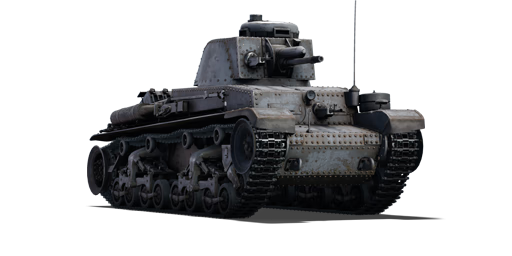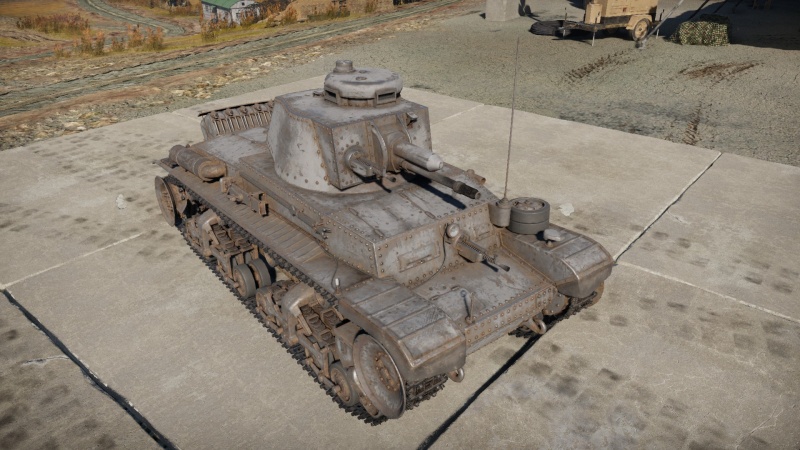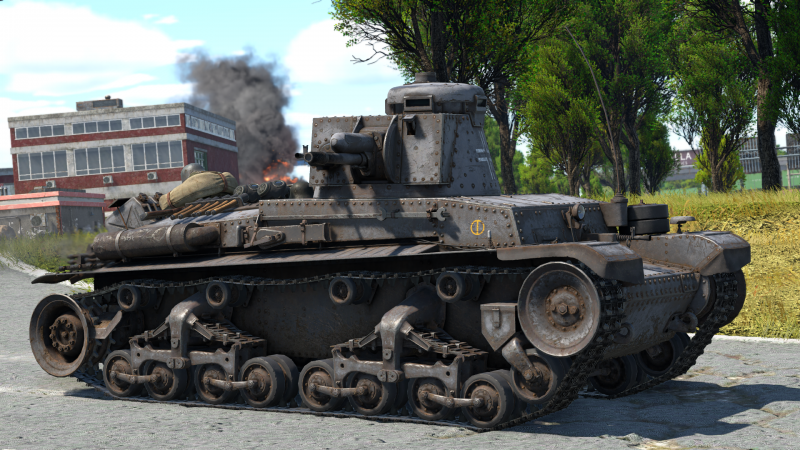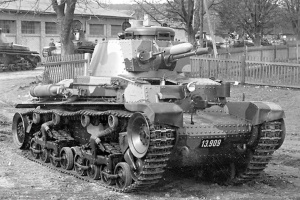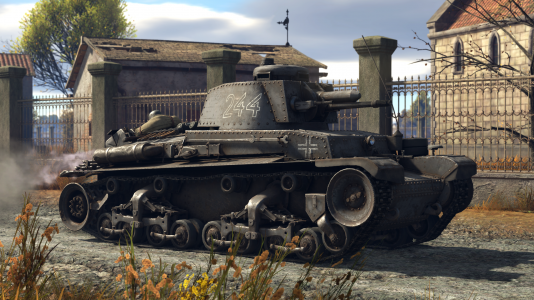Pz.35(t)
Contents
Description
The Panzerkampfwagen 35(t), also known as LT vz.35, was a Czechoslovakian light tank designed in 1935 by engineers at Škoda. The LT vz.35 was the most numerous tank in the Czechoslovakian army; during its serial production until 1939, 434 units were manufactured. After the German occupation of Czechoslovakia in 1939, these tanks were taken into service by the Wehrmacht, where they received the designation Pz.35(t) (Tschecherei: "Czech"). They formed the core of the German 1st Light Division and, after its reorganisation, the 6th Tank Division. The tanks were actively used by the Wehrmacht during the invasion of Poland, France, and the USSR in 1939-41. In smaller numbers, they were also used by the armies of Romania, Slovakia, Bulgaria, and Hungary, to which they were exported from Germany.
Introduced in Update 1.51 "Cold Steel", the Pz.35(t) represents an average but versatile vehicle, which copes well with a wide range of tasks on the battlefield. On the other hand, it does not excel in anything: in mobility, the Pz.35(t) is inferior to many other light tanks, and its armour and survivability are generally mediocre. However, the decent 37 mm gun and good frontal armour allow the vehicle to successfully perform the role of a "second line" machine.
General info
Survivability and armour
Armour type:
- Rolled homogeneous armour
- Cast homogeneous armour (Cupola)
| Armour | Front (Slope angle) | Sides | Rear | Roof |
|---|---|---|---|---|
| Hull | 25 mm (18°) Front plate 16 mm (80°) Front glacis 25 mm (31°) Lower glacis |
16 mm | 16 mm | 12 mm |
| Turret | 25 mm (10°)Turret front 25 mm Gun mantlet |
16 mm | 16 mm | 8 mm |
| Cupola | 25 mm (cylindrical) | 25 mm (4°) | ||
Notes:
- Suspension wheels and tracks are 15 mm thick while and torsion bars are 8 mm thick.
- The belly is 8 mm thick.
- Mudguards and fuel cans are 4 mm thick.
The Pz.35(t) has a key advantage over most low battle rated tanks which is found also on French tanks - it has 25 mm front armour on the hull and turret which makes it immune to 12.7 mm machine guns that are commonplace at its tier, however, the sides can be penetrated with such weapons. It has four crew with decent spacing between them, but a far cry from the Panzer III/IV, so while it can save you sometimes, don't rely on it, especially if a Soviet APBC or British 2-pdr shell is coming your way.
Mobility
| Game Mode | Max Speed (km/h) | Weight (tons) | Engine power (horsepower) | Power-to-weight ratio (hp/ton) | |||
|---|---|---|---|---|---|---|---|
| Forward | Reverse | Stock | Upgraded | Stock | Upgraded | ||
| Arcade | 38 | 38 | 10.5 | 186 | 229 | 17.71 | 21.81 |
| Realistic | 34 | 34 | 106 | 120 | 10.1 | 11.43 | |
With a top speed of 33 km/h and a power-to-weight ratio of 11.43 hp/ton in Realistic and Simulator battles, the Pz.35(t) has reasonably good mobility for a reserve tank. With a top speed almost 20 km/h faster than yours, Stuart and BT tanks are notable enemies as they will flank you quickly.
Modifications and economy
Armaments
Main armament
| 37 mm KwK34(t) | Turret rotation speed (°/s) | Reloading rate (seconds) | |||||||||||
|---|---|---|---|---|---|---|---|---|---|---|---|---|---|
| Mode | Capacity | Vertical | Horizontal | Stabilizer | Stock | Upgraded | Full | Expert | Aced | Stock | Full | Expert | Aced |
| Arcade | 72 | -10°/+25° | ±180° | Vertical | 13.3 | 18.5 | 22.4 | 24.8 | 26.4 | 4.29 | 3.80 | 3.50 | 3.30 |
| Realistic | 8.3 | 9.8 | 11.9 | 13.2 | 14.0 | ||||||||
The Pz.35(t) is armed with the 37 mm KwK 34(t), which has an APC shell with 55 mm pen and a Tier I unlockable APC shell with 53 mm pen, which is essentially worse in every aspect. It also possesses an 85 mm penetration APCR shell for more heavily armoured targets such as B1 bis.
Ammunition
| Penetration statistics | |||||||
|---|---|---|---|---|---|---|---|
| Ammunition | Type of warhead |
Penetration @ 0° Angle of Attack (mm) | |||||
| 10 m | 100 m | 500 m | 1,000 m | 1,500 m | 2,000 m | ||
| Pzgr. 34(t) | APC | 55 | 51 | 39 | 28 | 20 | 15 |
| PzGr. 40 | APCR | 81 | 73 | 45 | 24 | 13 | 7 |
| Pzgr.(t) umg. | APC | 53 | 50 | 37 | 26 | 19 | 13 |
| Shell details | ||||||||||||
|---|---|---|---|---|---|---|---|---|---|---|---|---|
| Ammunition | Type of warhead |
Velocity (m/s) |
Projectile mass (kg) |
Fuse delay (m) |
Fuse sensitivity (mm) |
Explosive mass (TNT equivalent) (g) |
Ricochet | |||||
| 0% | 50% | 100% | ||||||||||
| Pzgr. 34(t) | APC | 675 | 0.85 | 1.2 | 9 | 22.1 | 48° | 63° | 71° | |||
| PzGr. 40 | APCR | 980 | 0.37 | - | - | - | 66° | 70° | 72° | |||
| Pzgr.(t) umg. | APC | 675 | 0.82 | 1.2 | 9 | 22.1 | 48° | 63° | 71° | |||
Note: The PzGr. 34(t) round has no tracer.
Ammo racks
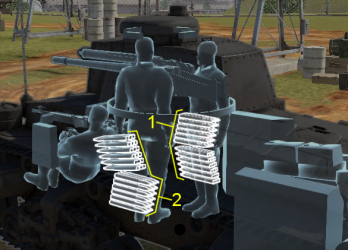
| Full ammo |
1st rack empty |
2nd rack empty |
Visual discrepancy |
|---|---|---|---|
| 72 | 37 (+35) | 1 (+71) | No |
Notes:
- Racks disappear after you've fired all shells in the rack.
- To go into battle with the right flank empty of ammo, pack 37 (+35) shells (rack 1 emptied).
Machine guns
| 7.92 mm MG37(t) | ||||
|---|---|---|---|---|
| Mount | Capacity (Belt) | Fire rate | Vertical | Horizontal |
| Coaxial | 1,800 (200) | 768 | N/A | N/A |
The small calibre of the MG37(t) machine gun makes it largely ineffective against all armoured vehicles but the ones with an open compartment. It still can be used to ping targets as a rangefinding help or to mow down minor obstacles blocking your line of sight.
Usage in battles
The tank is average in most aspects, aside from frontal immunity to .50 cals. Since your common enemies (eg. BT-5s) are faster than you, it is advisable to use this tank as a mid-range support vehicle. At the start of the match, avoid getting surrounded by enemies by not rushing to the frontline straight away, because its hull and turret traverse are all quite bad, making it vulnerable to surprise flanks. Find hilly terrain and utilise your 10 degrees gun depression to poke out, get a shot, then get back into cover before the enemies notice you.
At the middle stages of the match, only go to the frontline when you really need to, because, again, the traverse speed is low and the manoeuvrability isn't great. However the player can now use the tank's small profile to ambush enemies near a friendly point. With their decent penetration up close and the 22 g TNT, the APC rounds can quickly finish off anyone trying to de-cap the point.
Note that the default shell Pzgr. 34(t) has no tracer component, and the player can use this to their advantage. If the player misses the shot, the enemy will not see the trajectory of the shell thus will take longer to locate the shooter.
Enemies worth noting:
- BT-5, BT-7, M2, M3 Stuarts: If those tanks survive the first few minutes of point-capping, then they can silently appear pretty much anywhere on the map, including your side. To avoid being flanked / circled, do not put yourself at the frontline, as previously suggested. If you see / hear one of them sneaking up around you, turn your hull and turret together to double the traverse speed so it's quicker to get the guns on them.
- B1 bis: If it is not possible to avoid fighting this tank, then the best solution is to try and flank it. Hitting the side armour and knocking out its crew is the best way. In a face to face combat, load the APCR and aim for the near-vertical driver's compartment. The B1's driver and commander (also the gunner for the turret) are lined up so a penetration is likely to kill both of them, disabling its mobility and turret for 10 seconds or so. Also don't forget to avoid the hull-mounted 75 mm gun.
Pros and cons
Pros:
- Gun depression of -10° is great for combating across any terrain
- Stock and unlockable ammo with explosive filler have decent penetration and good post-penetration damage
- Mobility and acceleration are decent for the tier
- Frontally immune to 12.7 mm machine guns, useful against foes like M13 MGMC
- Reverse speed of -34 km/h is excellent at pulling the tank out of danger
- Has a shoulder stabiliser, useful for close-quarters combat and shoot-n-scoot
Cons:
- Many other tanks are faster than it, like BT-5, A13, M3
- Gun is inadequate against higher tier tanks like T-70, T-28
- Poor survivability and armour against anything stronger than machine guns
- Low agility: sluggish hull traverse and slow turret rotation
History
The Czechoslovakian LT vz. 35 was their main tank prior to the German occupation. with a total of 398 units built between 1936 and 1939, it was the main tank used by the German 6th Panzer division during the Battle of France and Operation Barbarossa before being phased out in favour of more modern German designs.
Development
The tank was a result of a competition between Českomoravská Kolben-Daněk and Škoda, the first one presented a variant of the LT vz. 34 coming at 8.5 while the second presented a new 10.5 ton model with more armour. Skoda's design was chosen and production was divided between the two manufacturers.
Early in the development the tank saw plenty of factory issues and reliability problems due to the rushed development and production, making it so that many units had to return to the factory for repairs involving mainly the electrical system.
The tank saw the interest of various countries, with Romania asking for 126 units, Afghanistan asking for 10 that where later sold to Bulgaria instead, and many others given to minor nations such as Hungary by Germany after the occupation.
Operational History
Czechoslovakian forces used the tank to supress protest and risings by the German Party of the Sudetes, and also to defend Slovakia from raids and incursions from Hungarian and Polish troops. After the German occupation they where used by Czech paramilitary groups armed and instructed by the German SS.
After the German Occupation, the tank was widely used by the 6th Panzer-Divisionen (6th Panzer Division) and where used on the Battle of France where they suffered moderate casualties.
During the Invasion of the Soviet Union the tank also participated but problems quickly rose up, the poor reliability and the inability of the tank to operate on very low temperatures quickly became a problem. Many where lost in combat and the tank proved ineffective even against soviet light tanks and specially against the T-34. Due to this poor performance Germany phased out the tank in 1942 and the remaining units where redistributed between Bulgaria, Slovakia, Romania and Hungary.
Bulgaria employed 26 units, some being the T-11 variant with a more powerful gun that where used in the 1st Tank Brigade until the arrival of Panzer IV tanks.
Slovakia used 52 units seized after their declaration of independence that where used for the suppression of anti-axis uprisings but 30 participated in the Invasion of the Soviet Union, most of which where destroyed or abandoned because of mechanical fails. The tanks where soon replaced by more modern units in 1943 being relegated to suppression of civic movements or training.
Hungary was impressed with the LT vz. 35 after capturing one during a conflict with Slovakia, and it was a great inspiration in the construction of the 40M Turan I developed by Skoda.
Romania was the 2nd largest user of the LT vz. 35 after buying 126 from Czechoslovakia, they where assigned to the 1st Armoured Regiment, participating in Operation Barbarossa an even in the Battle of Stalingrad covering the flanks of the Germany Army. In this last battle the unit lost 77 tanks with two thirds being lost to mechanical failures or abandoned. The tanks also participated in combat after the Romanian addition to the Allies, but the units where divided and some remained with the Axis while some remained went to the Allies.
| Archive of the in-game description | |
|---|---|
|
The Škoda LT vz.35 light tank was developed between 1935 and 1936. This tank was put into service in 1936, and by 1937 it had become the primary tank of the Czechoslovakian army. Between 1935 and 1940, 424 LT vz.35 tanks were produced. 218 tanks of this model were accepted into service in Wehrmacht and used until 1942. The tank was inferior to the Pz.38(t) in many ways, and its crews were not sorry to see it go. The tank was equipped with a pneumatic servomotor that made it easier to control the transmission and brakes. However, in winter condition on the Eastern Front it would freeze, and the tank would have to be warmed up. While in Wehrmacht service the tank's crew was also increased to four from the original three. The crew included a commander, a gunner, and a loader, who combined the duties of a radio operator and a mechanic/driver. The tank's power train was redesigned and made highly reliable. For example, the tracks could go for 8,000 km (almost 5,000 miles) before wearing out. These tanks were used in combat operations in Poland, France, and the USSR. But while the Pz. 35(t) was effective in Poland and France, in the USSR it was, more often than not, helpless. | |
Media
- Images
A Pz.35(t) in Eastern Europe
- Skins
- Videos
See also
- Other vehicles of similar configuration and role
- Pz.38(t) A / Pz.38(t) F - similar Czech-designed light tank, the successor to the Pz.35(t) in the German tech tree.
- T-26 (Family)
- A13 Mk I
- I-Go Ko
- M13/40 (Family)
External links
- [Development] Pz-35t & T-26-4
- [Wikipedia] Panzer 35(t)
- [Tanks Encyclopedia] Panzerkampfwagen 35(t)
- [Military Factory] LT vz. 35 / PzKpfW 35(t)
| Germany light tanks | |
|---|---|
| Pz.II | Pz.II C · Pz.II C (DAK) · Pz.II C TD · Pz.II F · Pz.Sfl.Ic |
| Sd.Kfz.234 | Sd.Kfz.234/1 · Sd.Kfz.234/2 · Sd.Kfz.234/2 TD |
| Marder | Marder A1- · Marder 1A3 · Begleitpanzer 57 · DF105 |
| SPz PUMA | PUMA · PUMA VJTF |
| Wheeled | Sd.Kfz.221 (s.Pz.B.41) · Class 3 (P) · Radkampfwagen 90 · Boxer MGS |
| Other | Ru 251 · SPz 12-3 LGS |
| Argentina | TAM · TAM 2C · TAM 2IP · JaPz.K A2 |
| Czechoslovakia | Pz.35(t) · Pz.38(t) A · Pz.38(t) F · Pz.38(t) n.A. · Sd.Kfz. 140/1 |
| France | Pz.Sp.Wg.P204(f) KwK |
| Lithuania | Vilkas |
| USA | leKPz M41 |
| USSR | SPz BMP-1 |


